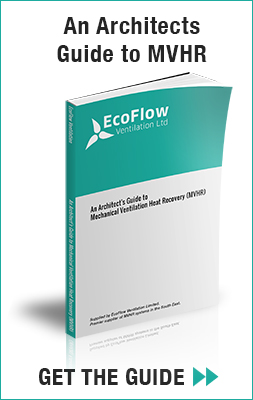The Passivhaus Trust provides guidance about how to build homes that offer significant comfort, build with impressive amounts of attention to the finest detail. The design is rigorous, complementing construction practices that have been developed by Germany’s well-respected Passivhaus Institute.
Passivhaus buildings are famous for the high levels of comfort they provide to people who live there, while using minimal amounts of energy for both heating and cooling the home. More and more people are building to Passivhaus standards and saving a great deal of money on energy as well as enjoying a healthier internal ‘climate’. So can you include MVHR in Passivhaus builds?
Yes, you can! And it’s a marvellous cultural fit. Get it right and your new build can be Passivhaus certified: something that’s future-proof, attracting buyers and investors as well as dramatically reducing the occupants’ heating and cooling costs.
How do mechanical ventilation heat recovery systems work?
Mechanical ventilation with heat recovery acts as a fan-powered ‘whole building’ ventilation system. It extracts stale, damp air from indoors, recovers the heat from it via the main unit, then delivers pre-warmed fresh air back into the rooms. The air moves between rooms via circulation spaces like stairs and hallways, gaps under doors and special grilles. The perfectly-balanced end result should be a free exchange of 100% interior air with 100% outdoor air. You don’t even need to fit trickle vents or room extract points.
Whole house ventilation systems for Passivhaus – What you should know
MVHR systems are already at the heart of more or less every ultra-low energy building design, including Passivhaus. In many ways they are absolutely essential, since the considerable air tightness of new builds means ventilation is a real issue for health and wellbeing. When they’re designed properly and specified correctly, Mechanical Ventilation Heat Recovery systems provide superb indoor air quality. They also help create a pleasant, draught-free interior.
Done right, such heat recovery systems comply beautifully with the requirements and testing procedures for energetic and acoustical assessment of Passive House ventilation systems, as laid down in November 2009.
Passivhaus builds benefit from very low energy bills, hardly needing any heating at all. They rely on passive heat sources like the sun, people, appliances and air from extractors, which together make a substantial contribution. Extra heat comes from the supply air, provided the maximum heating load is less than 10W per square metre of living space. This should be the only heat source if you want your build to qualify for Passivhaus certification.
House ventilation for health and comfort
When designed and specified by experts, MVHR complies with UK whole building ventilation regulations, to Part F. To comply, your system must:
- Recover more than 90% heat in the main unit
- Consume a total of 0.3W/m3h energy
- Include high grade filters to the main unit, minimum F7 for the intake and G4 for the extractor side of things
- The system must be the right size for the property, large enough to ventilate the whole building
- Air flows should have 3 control levels: basic at 70%, standard at 100%, increased at 130
- It’s good to have controls that include a boost function for extra ventilation
What you need to know about ventilation systems for Passivhaus homes
Does that tell you what you need to know? If you still have questions, we’ll be pleased to help and advise. Just get in touch.





Good article, thanks Joseph. I would clarify though that you can provide heating in a variety of ways for Passivhaus Certification, it’s not limited to heating via the air.
Yes fair comment Elrond, but as we deal in MVHR systems it was specific to this – Thanks for taking the time to visit and comment, it’s much appreciated.